 Deutsche Version
Deutsche Version
On February 12, 1947, near the siberian pacific coast one of the most
interesting meteorite falls of the 20th century occured. It was clear winter
weather, when at 10:38 local time an intense fireball, brighter than Sun,
crossed the sky and broke apart with roaring thunder just before hitting the
ground. Roughly 100 tons of meteoric material were shattered in ten-thousands
of fragments over the Sikhote-Alin mountains north of Vladivostok. The biggest
fragments crashed into the ground, causing craters of up to 26 meters in
diameter.
This event is one of the best-documented meteorite falls, but in the "West"
for long time there was little or nothing known about it. Fortunally, this
situation has changed the last years.
 |
The probable former orbit of the Sikhote-Alin meteoroide is similar to the
orbits of many small bodies of the solar system. It is ellipse-shaped and has
its point of biggest distance from Sun in the asteroid belt. This makes its
origin of the belt reliable - possibly it was born from the collision of
asteroids. During its 1132 day orbit round the sun the meteoroid was for just two days inside the Earth's orbit. The diagram to the left shows the situation one month before the collision; the point of the spring equinoxe is to the left. |
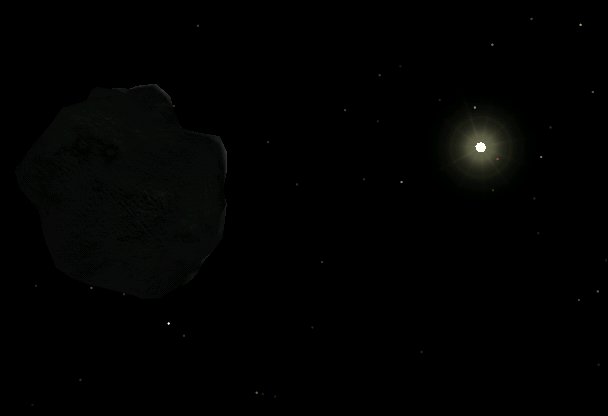 | On January 6, 1944 the meteoroid reached its perihelion for the last time (at least as an independent celestial body). The distance from Sun here was 147.02 million kilometers. Note the difference of the virtual size of the sun compared to the point of aphelion (below). |
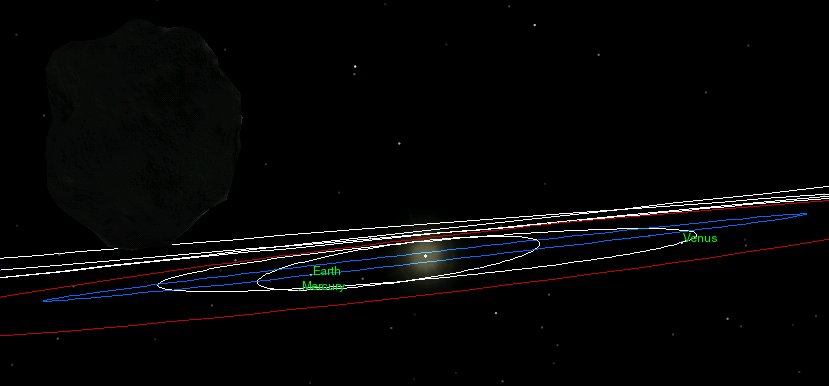
The farthest point from Sun was reached by the Sikhote-Alin meteoroide the
last time at August 6, 1945. The distance from Sun now was 468.68 million
kilometers. At this position, an observer would have seen a panorama of the
inner solar system.
For clearness the orbits of the planets have been plotted.Earth is marked blue,
Mars is marked red to give a better overview.
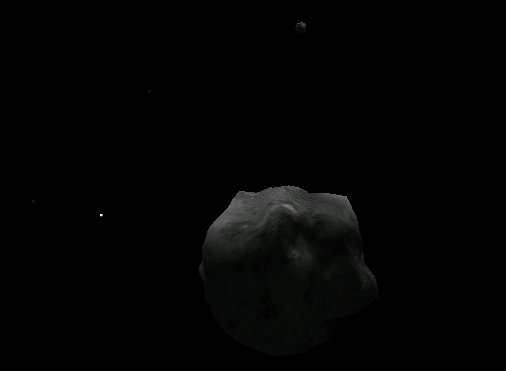 | While Earth was visible disklike already since the beginning of 1947, at February 1st the earth-and-moon system formed a celestial panorama above the meteoroid. Less than two weeks remained until crash. |
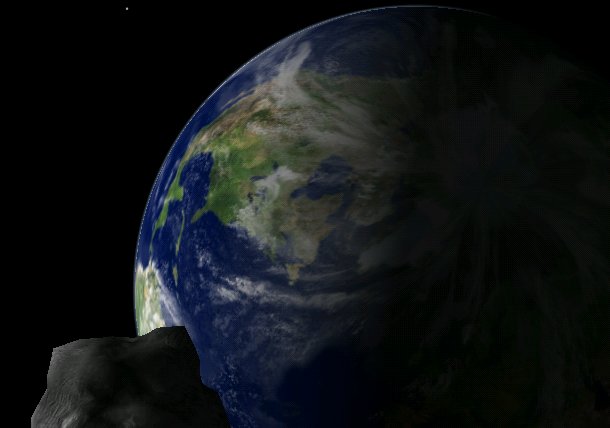 | This picture of Februar 11, 1947, six hours before impact, nicely shows the meteoroid's approach from northern of the ecliptic. To the right (in the picture at the lower right edge) the ice cap of the Earth and the polar ocean. For in February it's Winter on the northern hemisphere, they are in the shadow. More left is Canada in daylight. |
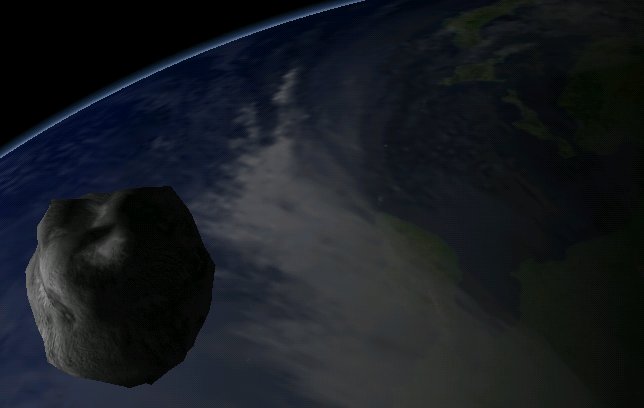 |
Eastern Sibiria straight ahead: roughly two hours before the crash there were
visible a number of details on Earth's surface. Between the clouds there is
the sibirian peninsula of Kamtchatka. The light blue line is earth's atmosphere, which Celestia displays in a correct way. |
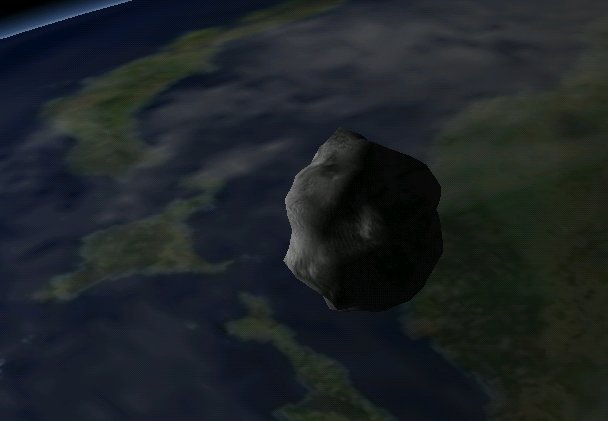 |
A few minutes before the fall on February 12, 00:38 universal time (10:38
local time) a visitor on the meteoroide had to make off speedy. The picture shows in the right half the dark stripe of the wooded Sikhote-Alin mountains. In reality, it was covered by snow in February 1947. In the ocean there is the island of Sachalin and, closer to the horizon, part of Japan. |
 | Few seconds before impact the meteoroid reaches the outermost border of earth's atmosphere at a heigth of 100 km. By air friction it is immediately heated up until white-hot. For some of the inhabitants of the planet below it now becomes visible as a bright fireball in the sky. |
|
The fireball which crossed clear sky from north-northeastern direction over
the Sikhote-Alin mountains was described by more than 240 eyewitnesses, of
which some statements are given in [7]. They agree the bolide was a single
body at first. A school girl described it "as though a piece of the Sun has
split off." With loud thunder as of cannons it then broke apart, in a
number of single explosions and not continiously, as the observers explicitly
mark. The parts had "the form of candlelights, they were followed by
little lights and sparks" but remained in the form a coherent flying
swarm. About the colour of the event there are different statements (reddish,
pink, blue or greenish). It is not clear if the statements describe the bright
heads of the meteoroides or the tails (compare the video tape of the Peekskill
meteorite of 1992!). A sixteen-year-old boy thought the meteor swarm was an american nuclear weapon - the bombing of Hiroshima was just one and a half year before. The flying swarm left a broad dark smoke trail in the sky which was visible for hours. From Iman, a city at the Transsibirian Railroad, the russian artist P. I. Medvedev recorded his personal impressions by a painting. |
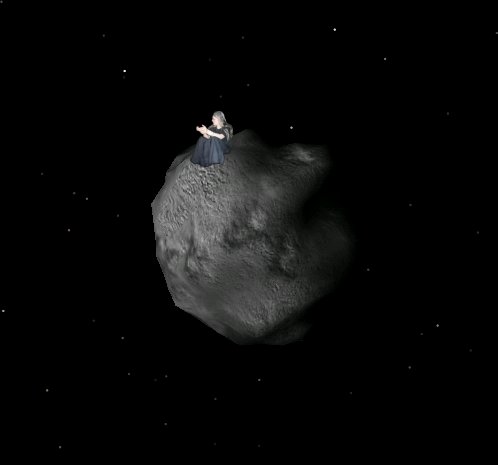 |
Following physical model equations, a meteoroid of Sikhote-Alin's size and
velocity should loose nearly half of its origin mass by atmospheric friction
[6]. Therefore, the body should have been of roughly 200 tons before entering
Earth's atmosphere. This correspondends to a sphere of 4 meters in
diameter. The graphics displays the size by an inserted sitting picture of the author. The shape of the body is hypothetic; however, for an octaedrite, a spheric-ellipsoidic to polyedric form is plausible [4]. |
The following diagrams keep close to the publication of Krinov [4], where the breakup of the meteoroide in the atmosphere is derived from the positions of specimens in the strewnfield. The phases of the breakup are clearly distinct. Slow "crumbling" which surely also occured during flight is not considered.
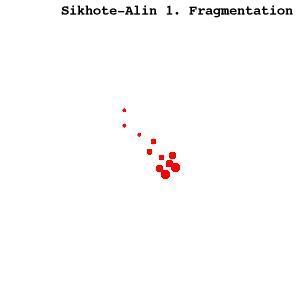 |
1st fragmentation
After the parent body had entered the denser layers of the atmosphere at a
height of 80 kilometers, it began to glow intense and became visible as
fireball. At a height of 10 kilometers, air drag is so high that the material
strength of iron cannot stand it longer. The body breaks up, and this is
called first fragmentation. |
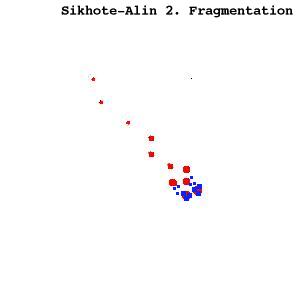 |
2nd fragmentation
At roughly 3 to 4 kilometers the next phase of breakup is reached. The air
density now is at a value that the bigger fragments, even if they posses a
much smaller cross-section than the original body, cannot stand the pressure.
The two biggest pieces of the swarm, now flying at the top, also break up in a
second fragmentation. |
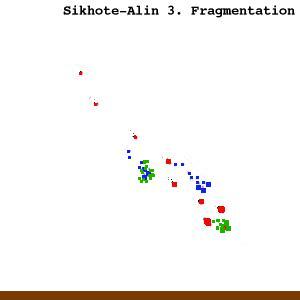 |
3rd fragmentation
Closer to the ground, at a height of 1500 meters, air density has increased
still more. Again some of the pieces can't stand the pressure, and for the
third time there is a breakup. |
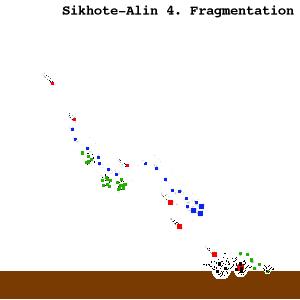 |
4th fragmentation
The biggest still existing pieces of the swarm have lost most of their initial
velocity, but they make still 500 meters per second when they crash into the
ground. By the impact they are crushed to thousands of splinters which are
thrown out between the craters. The biggest of the craters has a diameter of
26 meters and is 6 meters deep. |
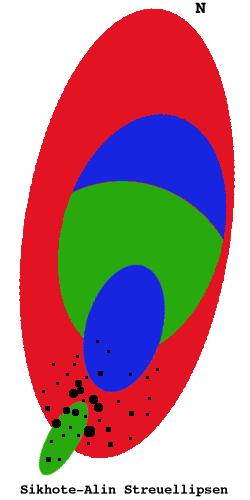 |
The diagram shows a schematic map of the Sikhote-Alin strewnfield. North is
up, the colours correspond to the above shown fragmentation diagrams. Red is the main fall ellipse, overlaid are the secondary ellipses of the second and third fragmentation. Fragments from the "green" zones usually are "too small" to have a position so far at the top of the strewnfield. Black circles mark big craters. Here are found the many scrapnels from the fourth fragmentation; all specimens from the red and blue/green ellipses are individuals. |
 |
To the left there are some examples of specimens from the Sikhote-Alin
meteorite strewnfield. There are two smaller scrapnels from the fourth
fragmentation, on both is visible how they have been stretched during the
impact. The other specimens are individuals which still possess their black fusion crust. The bigger one has developed rhegmaglyphs and probably is from second fragmentation. The smaller individual is more round and has only traces of melt pockets; possibly it origins from third fragmentation. The shown specimens are of masses 24, 21, 8 and 5 grams and belong to the private collection of the author. Not for sale.
|